28/07/2020 – Wicket12: Egyptian consortium develops first textile palm fibers — auf Deutsch lesen
PalmFil - Potential of date palm fiber newly discovered
Palmfil consortium develops first textile palm fibers and reinforcements extracted from the byproducts of pruning of date palms.
The fiber PalmFil is not only sustainable, but also economical in manufacturing, compatible with textile and composite processing and offers the properties needed for lightweight cars of the future.
Dr. Mohamad Midani, Partner, PalmFil Consortium:
“There are more than 140 million date palms mostly concentrated in the Middle East and North Africa, generating yearly more than 4.8 million tons (dry wt.) byproducts of pruning regarded as agriculture waste, such as frond and fruit stalks. This represented a burden on palm growers, and was the main cause of fire accidents and infestation by dangerous insects. Those byproducts could otherwise be transformed into 1.3 million tons/year natural textile fibers, ranking third after cotton and jute.”
There has been several previous attempts to extract fibers from date palm byproducts through crushing and grinding, resulting in a biomass rather than textile fibers. PalmFil consortium succeeded in extracting the first long textile fiber from such byproducts and converted it into fiber tow, chopped fiber, spun yarn/ roving, nonwoven mat, woven fabric, and unidirectional tape. The new fiber represent a sustainable material base for a wide spectrum of industries. Ranging from natural reinforcements for composites in automotive and sporting goods, plaster reinforcements in construction, burlap sacks for packaging, ropes, and twines, non-wood papers, and other consumer products.
Dilip Tambyrajah, Secretary General, International Natural Fiber Organization:
"Date palm byproducts have been used for centuries in the Middle East and it is a heritage related material. It is culturally embedded in Middle Easterns but possibly forgotten in modernity. Recent R&D conducted by PalmFil consortium demonstrates the potential of date palm fiber; its use in the modern context and in industrial settings. Revival of the fiber sector in the Middle East will need dedication and national commitment. The use of date palm fiber is not the issue. The use of most natural materials like the date palm fiber contribute towards maintaining biodiversity, provide employment and income and enable sustainable development in general."
Dr. Ahmed Hassanin, Partner, PalmFil Consortium:
“It has been a long five years marathon of self-supported research, relying completely on our personal funding and driven by a strong believe on the impact of such innovation on the sustainable development of rural communities and their livelihoods. We wanted to rediscover this underutilized resource, and prove to the whole world that we could economically extract textile fibers from it, without abiding to the agenda of any funding institution.”
The new date palm fiber
- is obtained from renewable bioresources
- does not cause deforestation or compete with food production
- is 100% biodegradable and compostable
- has specific tensile strength 5 times higher than structural steel, and equal to those of flax, hemp and sisal
- Its vibration damping and acoustical insulation is higher than those of glass and carbon
- its thermal insulation is higher than carbon
- can be easily blended with other long fibers such as flax, sisal, and abaca,
- could be chopped and blended with hemp, kenaf, and jute.
Lobna Elseify, Partner, PalmFil Consortium:
“We did a comprehensive research to optimize the extraction process and we did a thorough characterization of the new fiber. The research results were very well received by the scientific community and featured in research and review articles in some of the most prestigious scientific journals in the field, such as, Industrial Crops and Products (Elsevier) and Cellulose (Springer). The new fiber was also well accepted by the industrial community in Egypt, and it has been processed on a full industrial scale spinning line at the Egyptian Industrial Center of Flax. We are currently establishing connections with the leading automotive manufacturers in Europe, and we are conducting a dedicated research on date palm fiber composites in automotive.”
PalmFil technology
PalmFil technology contributes to the circular bioeconomy following a closed loop cycle from cradle to cradle. Moreover, the extraction technology could be applied to byproducts of other palm species such as oil palm, sugar palm, doum palm as well as other agriculture byproducts such as broomcorn.
PalmFil consortium have more than 50 years of combined experience in fiber science, textile technology and composite engineering. They are currently seeking partnership to further develop, scale-up, and commercialize PalmFil technology. They have recently launched a website to commercially announce their innovation, and they will present more about the new material in an upcoming live webinar that will be announced soon.





